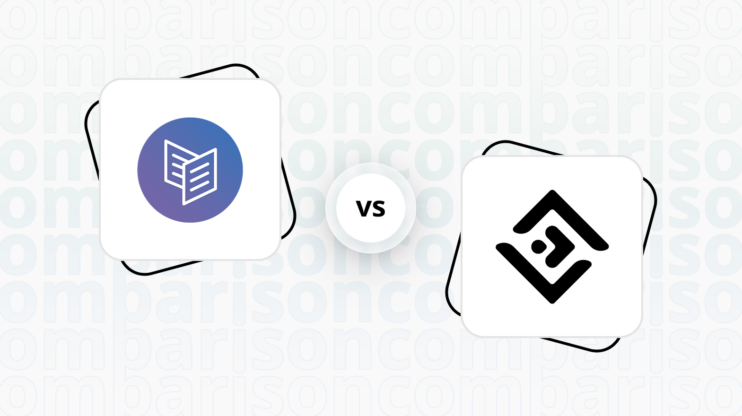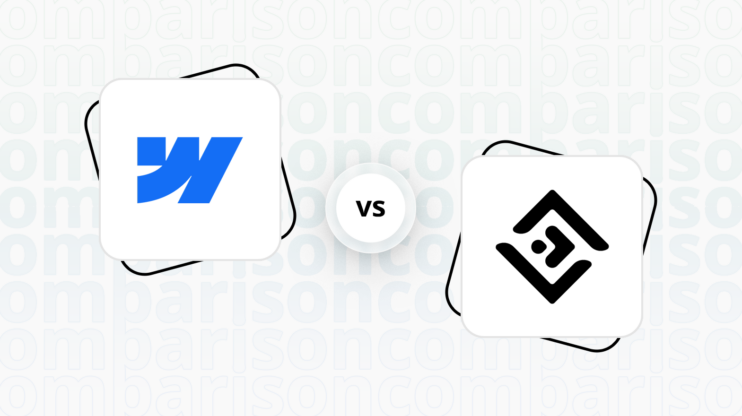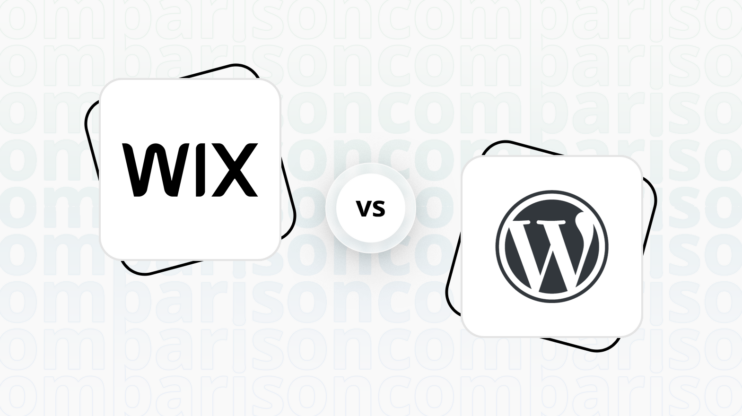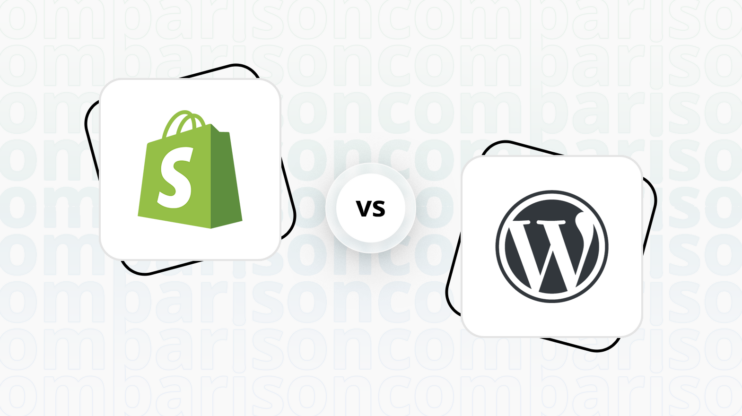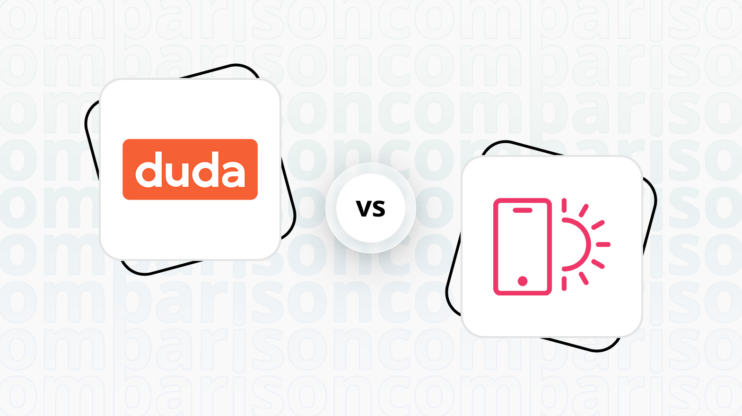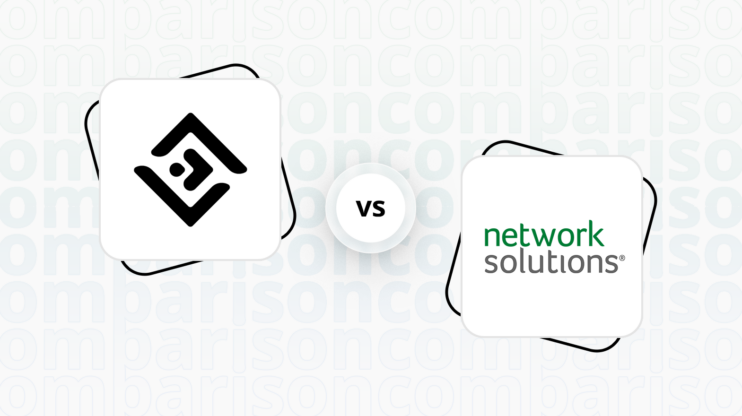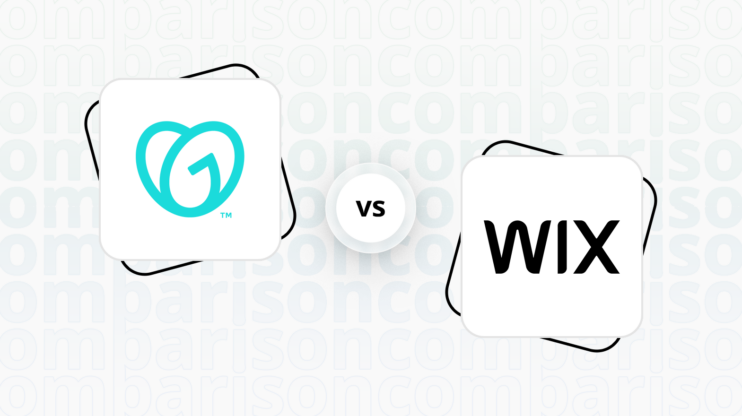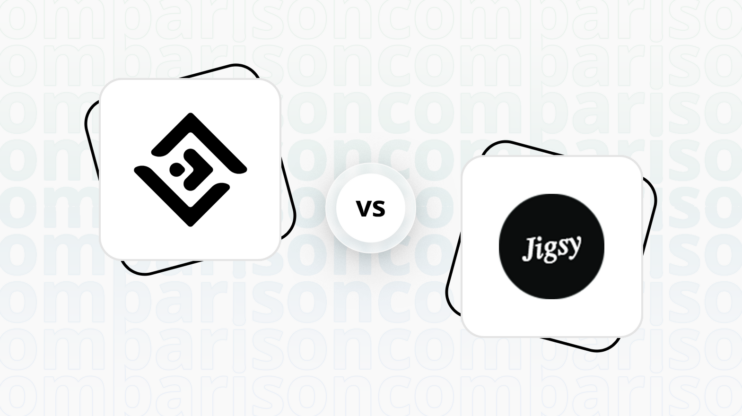Final verdict
Carrd and Webflow cater to different user needs and preferences, with each platform having its unique strengths.
-
Carrd (Overall Grade: 6.1/10)
excels in simplicity and affordability, making it an ideal choice for individuals and small businesses looking to create single-page websites quickly and efficiently. Its user-friendly interface, ease of use, and straightforward design capabilities are highly praised by users. However, it falls short in areas like ecommerce, advanced design customization, and comprehensive features that larger businesses or more complex projects might require. -
Webflow (Overall Grade: 7.9/10)
stands out for its powerful design tools, flexible CMS, and comprehensive solution for creating custom, responsive websites. It is favored by professional designers and businesses seeking a high degree of creative control and scalability. While it offers a steeper learning curve compared to Carrd, its extensive learning resources, superior ecommerce features, and robust customer support make it a compelling choice for users willing to invest more time and resources into their website.

|

|
|
|---|---|---|
|
Design functionalities & templates |
7.5 |
8.6 |
|
Ease of use |
9.0 |
7.5 |
|
Ecommerce |
3.5 |
8.5 |
|
Website Editors |
7.0 |
9.0 |
|
Product testing options |
6.0 |
6.3 |
|
Price |
8.9 |
8.0 |
|
Hosting quality |
5.0 |
8.9 |
|
Website speed optimization |
8.2 |
8.1 |
|
Plugins/extensions and integrations |
5.8 |
5.5 |
|
Marketing features |
5.8 |
7.8 |
|
Customer support |
6.2 |
8.3 |
|
Website security |
7.6 |
7.8 |
|
AI capabilities |
0.0 |
8.3 |
|
User management |
4.3 |
8.3 |
| Overall |
6.1 |
7.9 |
Best for ecommerce
 3.5
3.5
 8.5
8.5
Verdict
: For users seeking a robust ecommerce solution with extensive customization and powerful features, Webflow is the clear winner. Carrd serves well for basic ecommerce needs but falls short for more complex online stores.
-
Carrd
: Offers a simple solution for small-scale ecommerce projects, primarily through third-party integrations. It’s best suited for users who need minimal ecommerce capabilities alongside their single-page websites. -
Webflow
: Stands out with its comprehensive ecommerce features, including advanced product page customization, a wide range of payment gateways, and detailed analytics. It’s ideal for businesses looking to build and scale their online stores with a high degree of customization and control.
Best for informational & business websites
 7.9
7.9
 8.6
8.6
Verdict
: Webflow is the superior choice for informational and business websites, offering advanced design capabilities and a higher degree of customization.
-
Carrd
: Carrd shines in its simplicity and ease of use, making it a great option for creating single-page or simple informational websites. Its straightforward interface and affordable pricing plans are particularly appealing for individuals and small businesses. -
Webflow
: Webflow stands out with its powerful design tools and flexible CMS, catering to users who require more sophisticated websites. It’s ideal for businesses looking for a comprehensive solution to create custom, responsive websites with a professional look.
Detailed comparison
Design functionalities & templates
Design FunctionalitiesRepresents how well each platform allows for creative design and customization of websites.Score Components:
- Template Variety (30%): Range and quality of design templates.
- Customization (30%): Flexibility and options for design alterations.
- User Interface (20%): Ease and intuitiveness of the design process.
- Responsiveness (10%): Adaptability to different devices and screen sizes.
- Innovation (10%): Unique design features and tools.
 7.5
7.5
 8.6
8.6
🏆
Winner: Webflow.
If you’re looking for a platform that offers more creative control and a wide array of design features, Webflow is the preferred choice.
Carrd is a versatile platform that offers a wide variety of templates and designs, catering to different needs and preferences. Users can choose from a broad selection of themes, ranging from simple and minimalist to complex and dynamic layouts, ensuring there’s something for everyone. The platform continuously updates its library with new designs, keeping up with the latest trends in web design. With its user-friendly interface, Carrd makes it easy for users to customize templates, allowing for a high degree of personalization and creativity in creating unique websites.
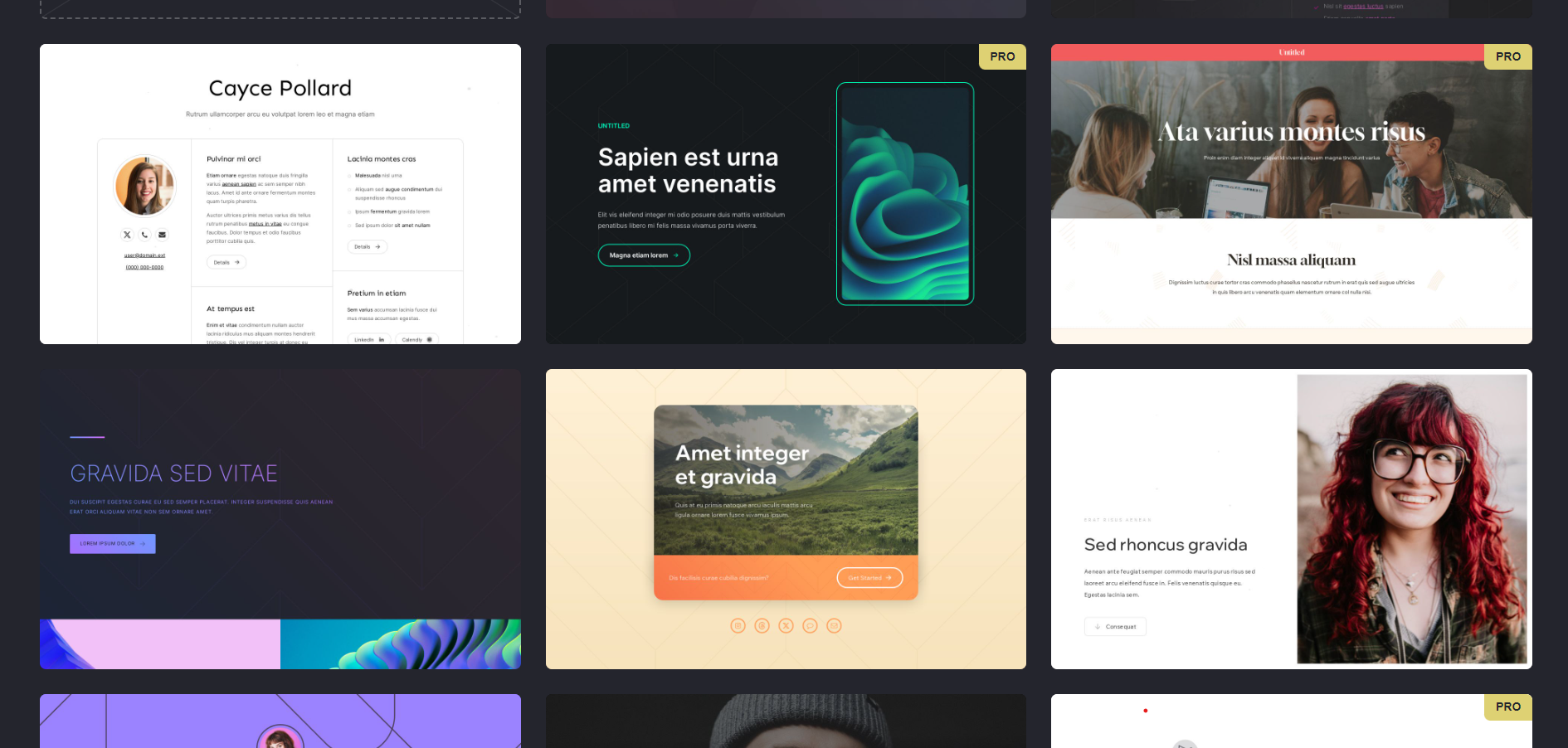

Compared to Carrd, Webflow delivers a robust design experience with a diverse range of template and customization options. Boasting over 1000 pre-built templates covering various industries and website types, including free and premium options, Webflow ensures a constantly evolving library for users. Templates are categorized for easy browsing, considering industry, website type, style, and features. The design customization features include a visual drag-and-drop editor for real-time adjustments, fine-grained control over every aspect of the design, and the ability to inject custom code for advanced users seeking additional personalization and unique functionalities.
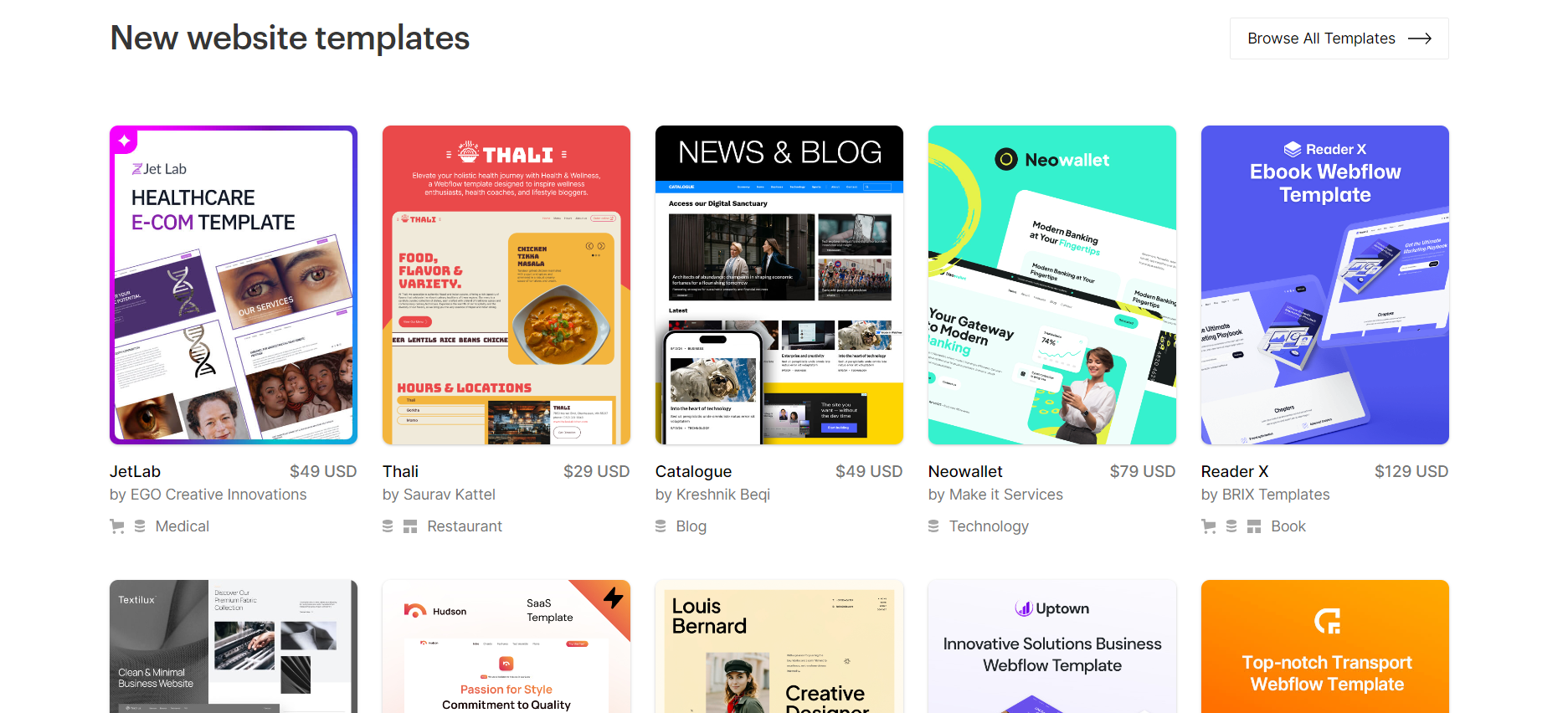
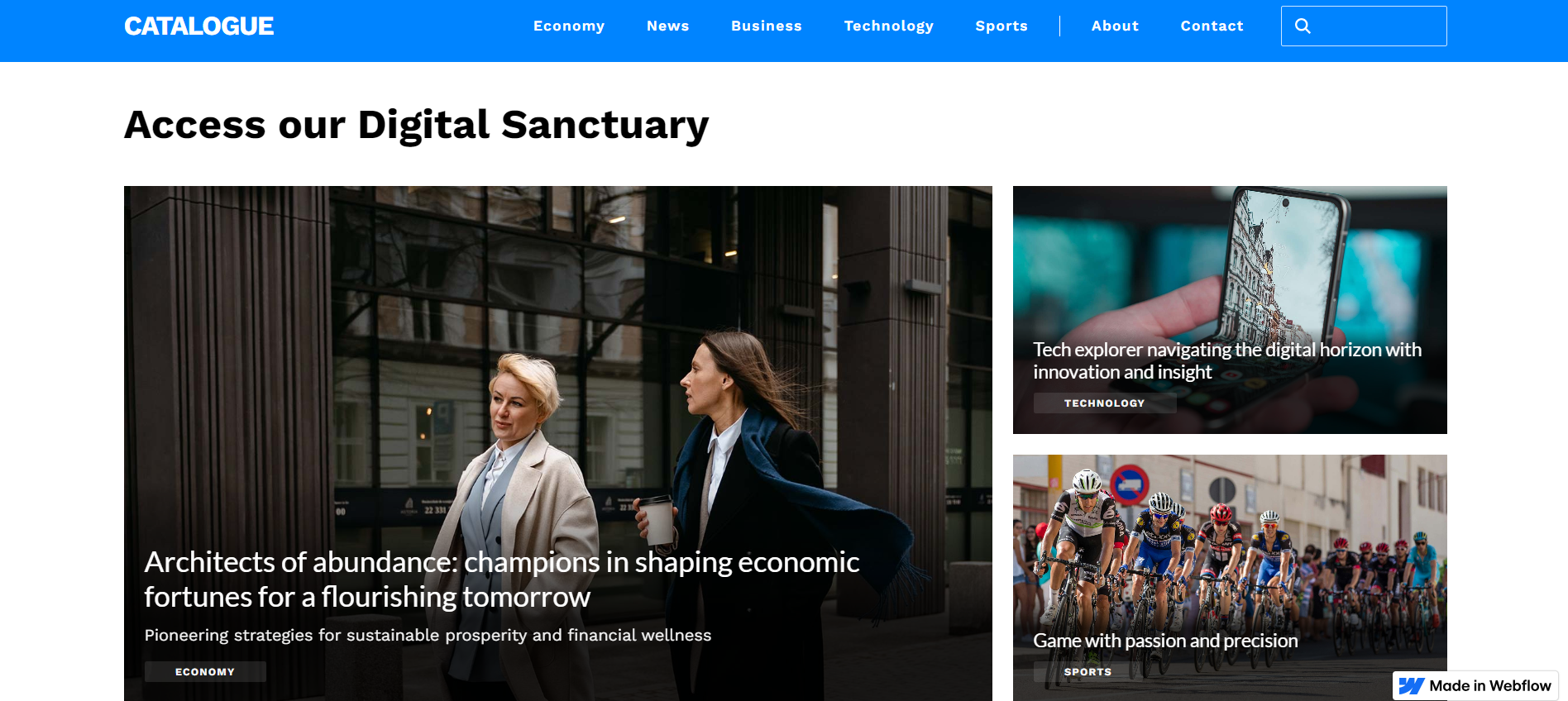
Get a head start on website creation with AI
Create a custom website tailored to your business needs 10X faster with 10Web AI Website Builder!
Ease of use
Ease of useReflects the platform’s overall user-friendliness.Score
Components:
- Learning curve (40%): Quickness and ease of getting started.
- Interface design (30%): Simplicity and intuitiveness of layout.
- User guidance (20%): Quality of tutorials and support.
- Flexibility (10%): Adaptability to various user skills.
 9.0
9.0
 7.5
7.5
🏆 Winner: Carrd
. Scoring a solid 9.0, Carrd stands out for its simplicity and ease of use, making it ideal for beginners and those seeking to create single-page websites quickly. Webflow, with a score of 7.5, offers a robust platform but with a steeper learning curve, especially for those new to web design. If ease of use is a priority, Carrd is the clear winner in this category.
Learning Resources
🏆 Winner: Webflow
. While both platforms offer solid learning resources, Webflow goes a step further with its comprehensive set of learning resources, including diverse courses and tutorials covering fundamental to advanced aspects of the platform.
For ecommerce
EcommerceMeasures the platform’s effectiveness in supporting online business activities.Score Components:
- Ecommerce themes and templates (20%): Variety and design of templates.
- Product management (25%): Ease of managing and organizing products.
- Payment options (25%): Variety and convenience of payment methods.
- Ecommerce features (20%): Features for managing an ecommerce store.
- Integration (10%): Compatibility with external e-commerce tools and services.
 3.5
3.5
 8.5
8.5
When it comes to ecommerce, Webflow clearly outperforms Carrd. While Carrd is a simple and lightweight platform primarily designed for building one-page websites, it lacks robust ecommerce features. Users looking to incorporate ecommerce functionalities would need to integrate third-party services or use external links to platforms like Etsy or Shopify. This can be a downside for those seeking an all-in-one solution with comprehensive ecommerce tools, inventory management, and payment processing directly within the platform.

|

|
|
|---|---|---|
|
Ecommerce themes and templates |
4.5 |
7.5 |
|
Product page customization |
3.0 |
8.3 |
|
Payment processing and commissions |
5.0 |
7.8 |
|
POS capabilities |
0.0 |
6.5 |
|
Payment gateways |
5.5 |
8.0 |
|
Product numbers |
2.0 |
7.0 |
|
Additional ecommerce features |
3.5 |
7.9 |
Carrd ecommerce features:
- Paypal and Stripe Integration
- External Widgets integrations
- Basic Product Listing options
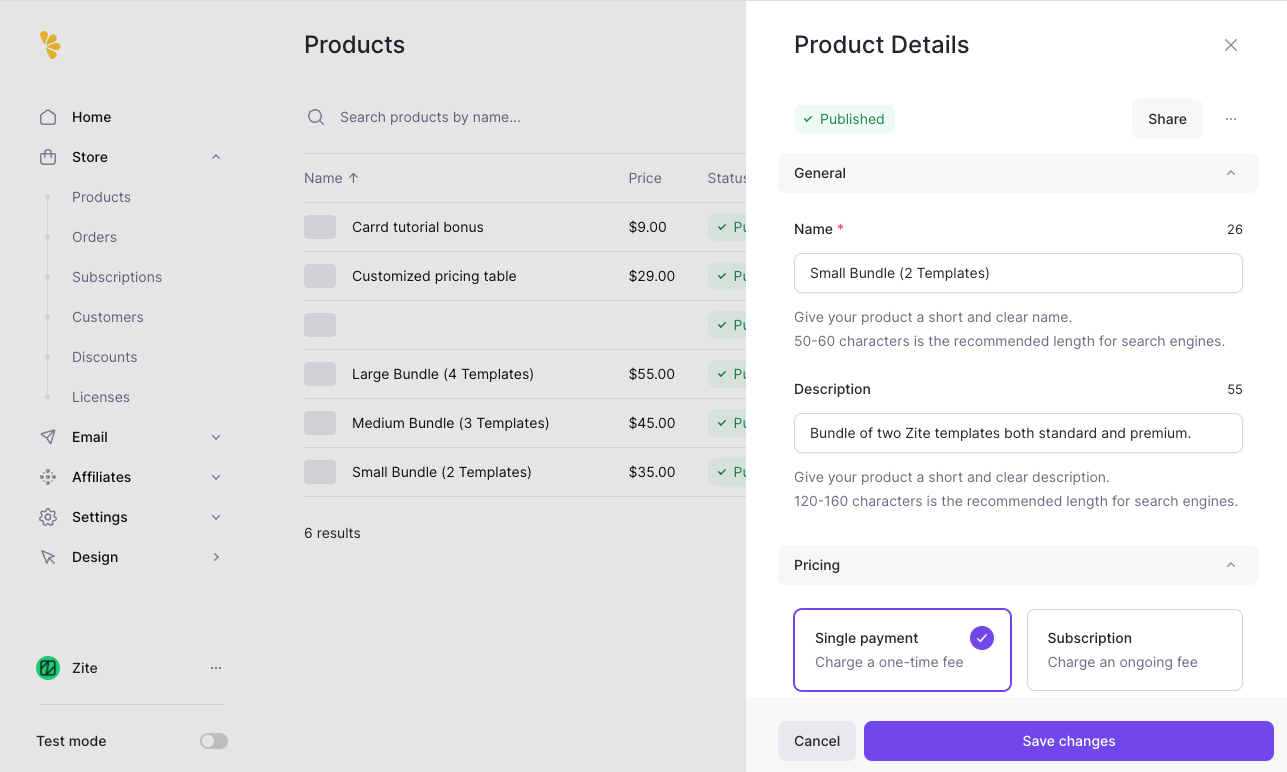
Webflow ecommerce features:
- Checkout and Payment Processing with Stripe, PayPal, etc.
- Marketing and Promotions
- Tax and Shipping calculations
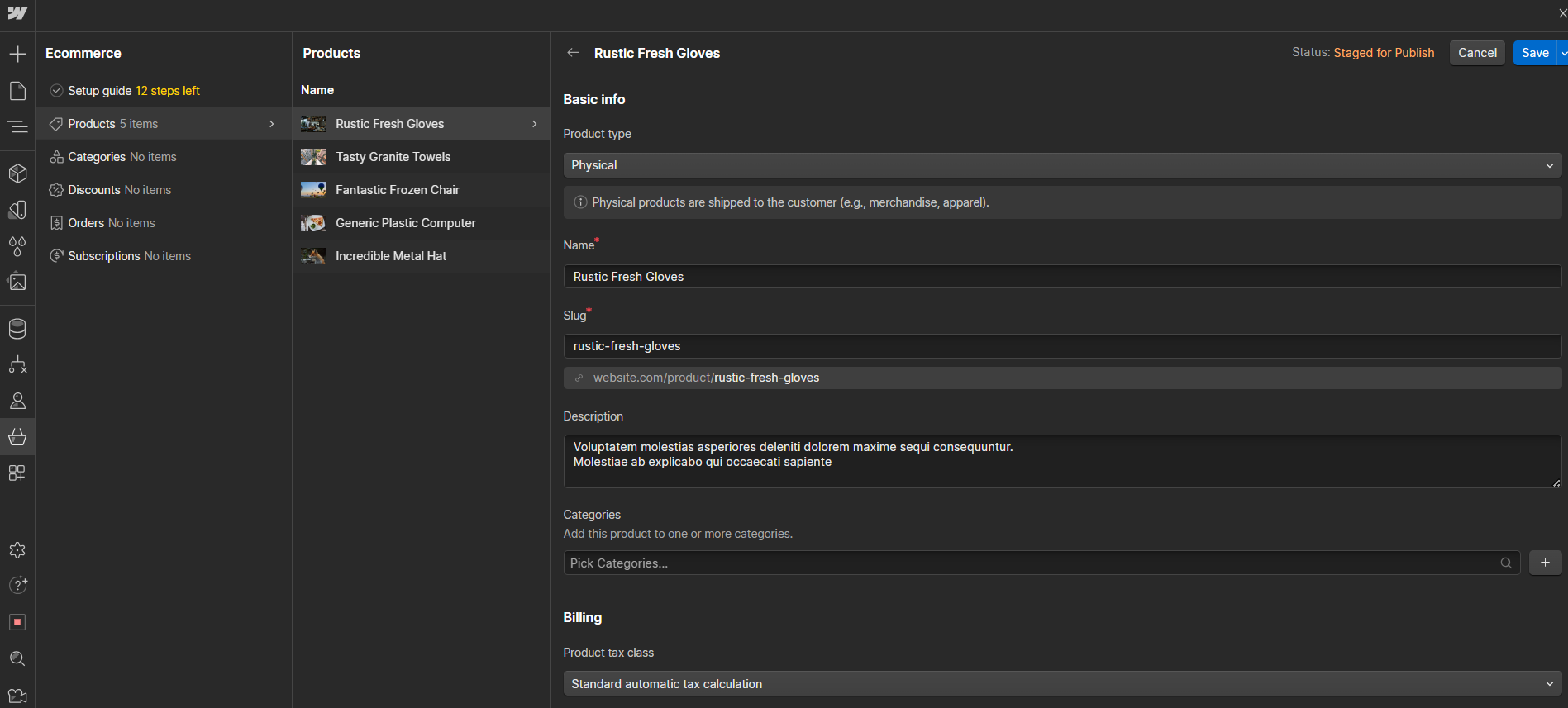
Ecommerce themes & templates
Carrd provides a selection of 14 e-commerce templates aimed at users looking to quickly launch online stores for products ranging from e-books to physical goods. These templates are crafted with a focus on simplicity and conversion optimization, featuring designs that vary from dark themes to minimalist aesthetics. They are priced starting at $19 or $25, depending on the template, and require a Pro Standard account or higher due to the use of advanced elements and widgets.
On the other hand, Webflow offers a diverse range of ecommerce themes and templates designed to cater to various types of online stores, from fashion and technology to artisan crafts and children’s products. Each template comes equipped with built-in ecommerce functionality, allowing you to easily add products and manage your store without the need for coding.
Product page customization
Carrd offers a streamlined approach to ecommerce product page customization, primarily through integrations with third-party platforms such as Stripe, Lemon Squeezy, and Gumroad. Users can create product pages within Carrd by adding product details like name, description, image, and price, and then integrate a checkout button using Carrd’s Widget element for platforms like Stripe. Users can integrate third-party services for ecommerce functionalities, but the customization possibilities for product pages would then depend on the capabilities of those external platforms.
In contrast, Webflow offers extensive customization options for eCommerce product pages, allowing users to design and personalize their pages without coding. It provides tutorials for creating product pages from scratch, offers responsive templates for various devices, and allows users to add custom code and dynamic content using Webflow’s CMS for maximum customization flexibility.
Payment processing
Carrd allows for payment-enabled forms for Pro Plus users or higher, integrating with Stripe Checkout for payment processing. This setup enables creating forms for various transactions like order forms or paid email lists. The process requires setting up the payment through Stripe, either via a preconfigured price or a custom price, and entering Stripe API keys. There’s no direct mention of Carrd charging commissions or offering POS capabilities within this documentation. For payment gateways, it specifically supports Stripe and Paypal.
Webflow, on the other hand, provides a flexible and secure platform for payment processing and ecommerce through integrations with leading payment gateways like Stripe and PayPal. This allows users to accept a wide range of payments, including credit card transactions directly from their websites. Given the versatility of Stripe and PayPal, businesses can manage online sales efficiently, and these integrations likely support various transaction types, potentially including POS transactions for physical sales environments.
Website Editors
Website EditorsEvaluates the platforms’ website building and editing capabilities.Score Components:
- Customization tools (40%): Range and power of editing features.
- Editor usability (30%): User experience within the editor.
- Design flexibility (20%): Freedom in layout and design changes.
- Update and maintenance ease (10%): Simplicity of updating and maintaining the site.
 7.0
7.0
 9.0
9.0
🏆
Winner: Webflow
. With a score of 9.0, Webflow’s website builder editor is praised for its intuitive visual interface that simplifies the process of designing and editing responsive websites without requiring deep technical knowledge. It offers a perfect blend of ease of use for beginners and the flexibility for more advanced users, enabling significant cost savings by allowing users to customize and manage their sites without hiring professionals.
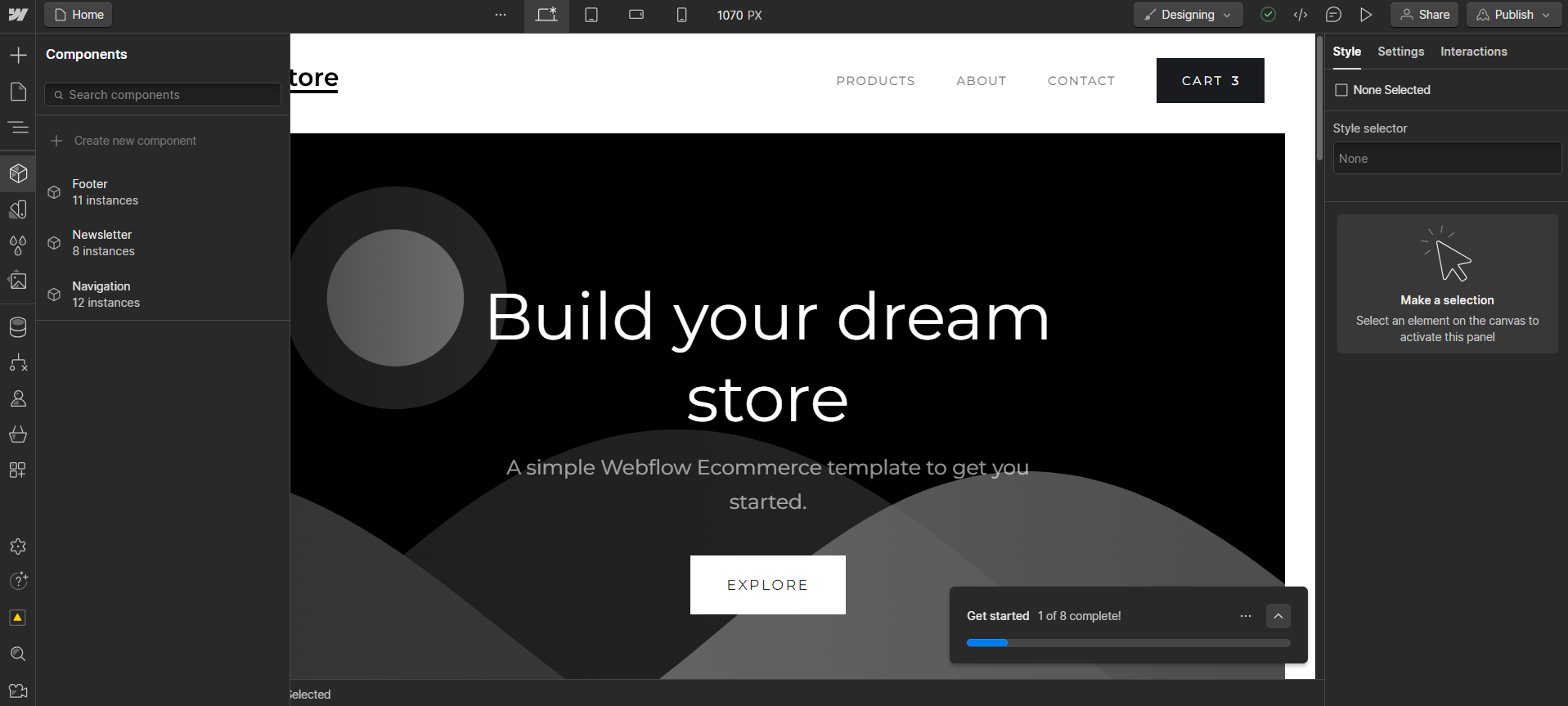
Carrd’s website builder editor, scoring 7.0, is designed for simplicity and efficiency, catering primarily to users looking to create single-page websites. It offers a user-friendly interface that allows for easy drag-and-drop functionality, enabling users to add, customize, and position elements such as text, images, buttons, and forms with minimal effort. While it may not offer the same level of design flexibility as Webflow, Carrd’s editor is optimized for simplicity and functionality, making it a generally approachable tool for users of varying skill levels.
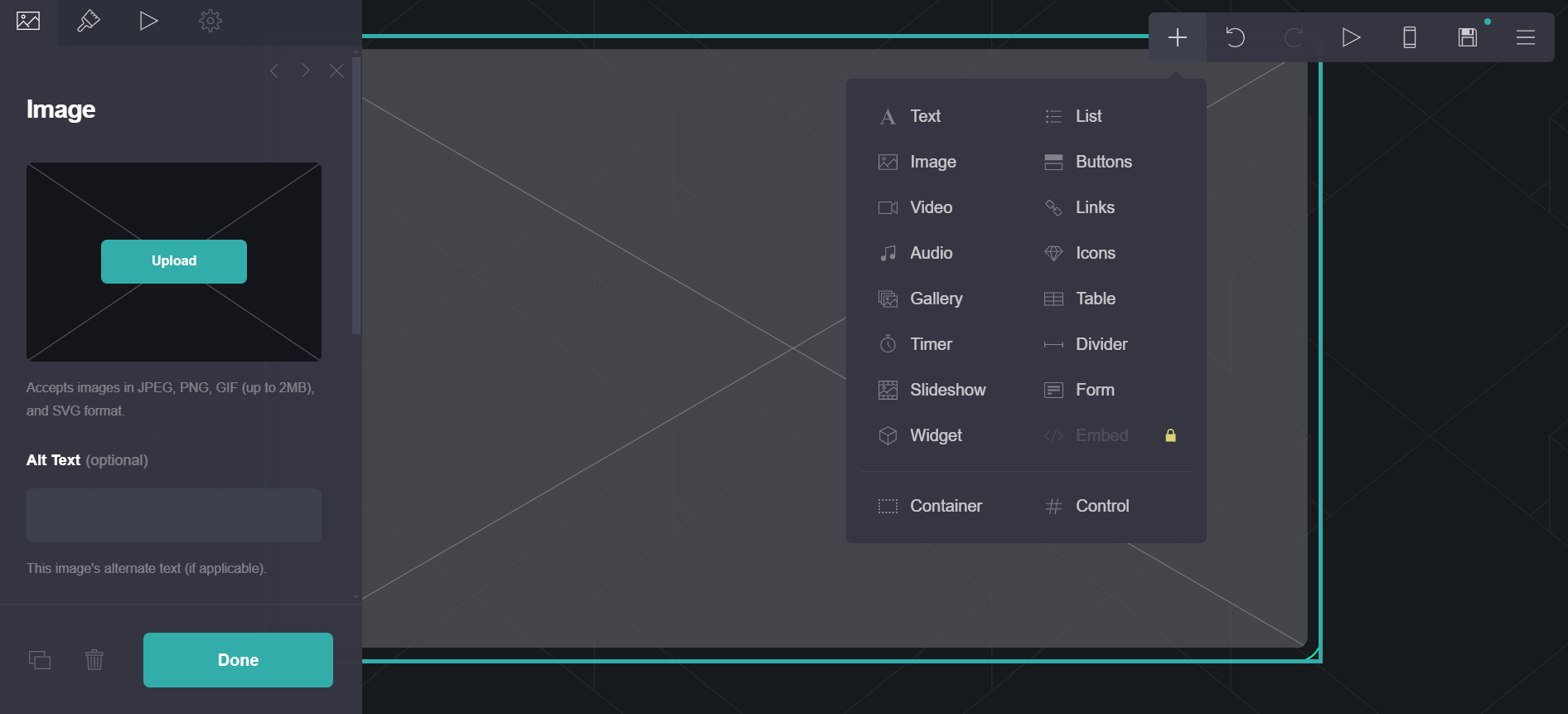
Mobile editor/app
 5.5
5.5
 7.0
7.0
🏆
Winner: Webflow
. Both Carrd and Webflow do not have official mobile editor apps. However, Webflow has a third-party app called EditFlow, created by a community member for Webflow users, which is currently only available for iOS. This gives Webflow an edge over Carrd, which only allows editing on a mobile browser. Despite this, both platforms could improve their mobile editing capabilities to enhance user experience.
Product testing options
Product Testing OptionsAssesses the options for trying out platform features before commitment.Score Components:
- Trial quality (40%): Extent and usefulness of the trial or free version.
- Feature accessibility (30%): How many features are available to test.
- Trial duration (20%): Length of the trial period.
- Ease of transition (10%): Smoothness of moving from trial to paid plans.
 6.0
6.0
 6.3
6.3
Overall Result
:
Webflow wins
. Webflow scores slightly higher than Carrd with a score of 6.3 compared to Carrd’s 6.0. While Carrd offers a 7-day free trial to test premium features, Webflow offers a free plan to test some basic features. Neither of the platforms offers a money-back guarantee.

|

|
|
|---|---|---|
|
Free Plan |
No |
Yes |
|
Trial Duration |
7 days | No trial |
|
Testing Premium Features |
During free trial |
With free plan |
|
Money Back Guarantee |
No | No |
Price
PriceLooks at the cost-effectiveness and value for money of each platform.Score Components:
- Plan value (40%): What each pricing tier offers.
- Transparency and clarity (30%): Clearness of pricing structures.
- Flexibility of plans (20%): Range of options to suit different budgets.
- Hidden costs (10%): Additional expenses not included in the plan.
 8.9
8.9
 8.0
8.0
Carrd offers more affordable pricing plans, making it a great choice for individuals and small businesses. However, Webflow provides more comprehensive features and flexibility, especially for larger businesses and enterprises.

|

|
|
|---|---|---|
|
Free |
No offering at this amount. |
Starter (Free): Limited features for new sites, including 2 static pages and 50 form submissions lifetime. |
|
$0-$1 |
Pro Lite ($0.75/month): Basic features suitable for simple, personal websites. Up to 3 1-page websites. Value for price: 6.0 |
No offering at this amount. |
|
$1-$3 |
Pro Standard ($1.58/month): Offers more features and flexibility, ideal for professional profiles and small projects. Up to 10 1-page websites. Value for price: 7.5 |
No offering at this amount. |
|
$3-$10 |
Pro Plus ($4.08/month): Enhanced features for more complex sites, including additional customization options. Up to 25 1-page websites. Value for price: 8.5 |
No offering at this amount. |
|
$10-$20 |
No offering at this amount. |
Basic ($18/month): Suitable for simple sites with a custom domain, including basic SEO controls and 500 monthly form submissions. And 100 pages. Value for price: 6.5 |
|
$20-$30 |
No offering at this amount. |
CMS ($29/month): For content-driven sites with 2,000 CMS items, 1,000 monthly form submissions, and full API access. And 150 website pages. Value for price: 7.5 |
|
$40-$45 |
No offering at this amount. |
Standard ($42/month): For new businesses with up to 500 ecommerce items, includes basic ecommerce features, and 2% transaction fee Value for price: 8.5 |
|
$45-$50 |
No offering at this amount. |
Business ($49/month): High traffic capacity, advanced features like site search, and up to 10 content editors. Value for price: 8.0 |
|
$80-$90 |
No offering at this amount. |
Plus ($84/month): Higher volume businesses with 0% transaction fees, up to 5,000 ecommerce items, and advanced features. Value for price: 9.0 |
|
$200+ |
No offering at this amount. |
Advanced ($235/month): Scalable solution for large online stores with up to 15,000 ecommerce items and the highest caps and 0% transaction fees. Value for price: 9.5 |
location. As a result in rare cases the prices displayed here can differ from the ones you see on their
websites.
Hosting quality
Hosting
qualityExamines the reliability and performance of the hosting solutions.Score Components:
- Uptime (40%): Consistency and reliability of website availability.
- Speed (30%): Loading times and performance.
- Bandwidth and storage (20%): Sufficiency of resources provided.
- Data centers (10%): Quality and distribution of hosting infrastructure.
 5.0
5.0
 8.9
8.9
Winner: Webflow
. Webflow offers managed hosting with a 99.99% uptime guarantee (on the Enterprise plan), and leverages a globally distributed network of data centers from Amazon Web Services (AWS) and Fastly. Carrd, on the other hand, offers shared hosting without specific information on bandwidth or storage limitations, and does not provide any statistics on uptime or have an uptime guarantee. Webflow’s superior hosting quality earns it a higher rating.

|

|
|
|---|---|---|
|
Do they offer hosting? |
Yes, shared hosting integrated with its website-building platform |
Yes, included in all of their plans |
|
Data Centers: |
Carrd doesn’t publicly disclose any information about its data centers |
Webflow doesn’t actually have its own data centers. Instead, it relies on a globally distributed network of data centers from Amazon Web Services (AWS) and Fastly |
|
Type of hosting: |
Shared Hosting |
Managed Hosting |
|
Uptime: |
Carrd.co does not provide any statistics on uptime |
99.99% |
|
Uptime Guarantee: |
Carrd.co does not provide any uptime guarantee |
Only Enterprise plan, 99.99% |
Website Speed Optimization
Website Speed OptimizationEvaluates optimization of website loading timesScore Components:
- PageSpeed Score (30%): Google’s score indicating performance optimization.
- Loading Time (30%): The average time until a website is fully interactive.
- Mobile Optimization (15%): Optimization effectiveness for mobile devices.
- Resource Optimization (15%): Optimizing images, scripts, and other heavy resources.
- CDN Usage (10%): Use of CDN to enhance speed across geolocations.
 8.2
8.2
 8.1
8.1
🏆 Winner: Carrd
Both Carrd and Webflow prioritize website performance and speed, but Carrd’s simplicity and efficient design give it a slight edge in this category.

|

|
|
|---|---|---|
|
Focus |
Mobile Responsive design, Caching, CDN |
Custom Cache Settings, Lazy Loading, CDN |
|
Performance Tools |
Cloudflare CDN |
Custom Element Lazy Loading, CDN |
|
Key Strategies |
Mobile Responsive design, Caching, CDN |
Custom Cache Settings, Lazy Loading, CDN |
|
Load Times |
Minimal due to simplicity |
Below 2 seconds average |
|
Page Speed Scores Range |
High due to simplicity |
77.2/100 |
|
Core Web Vitals Improvement |
Not disclosed |
Emphasis on LCP, FID, CLS improvements |
Carrd, a platform for building single-page websites, prioritizes mobile responsive design, caching, and the use of a Cloudflare CDN for speed optimization. Given the simplicity of websites built with Carrd, load times are expected to be minimal, and page speed scores are expected to be high. However, Carrd does not disclose any specific information related to Core Web Vitals improvements.
On the other hand, Webflow, a responsive website builder and hosting platform, focuses on custom cache settings, custom element lazy loading, automatic minification, responsive templates, and CDN for speed optimization. The average load time for Webflow websites is below 2 seconds, and the average PageSpeed score is 77.2/100. Webflow also emphasizes improving components’ usability and Core Web Vitals, specifically LCP, FID, and CLS.
Get a head start on website creation with AI
Create a custom website tailored to your business needs 10X faster with 10Web AI Website Builder!
Plugins and integrations
Plugins and integrationsMeasures the range and effectiveness of additional plugins and integrations.Score Components:
- Variety of options (40%): Range of available add-ons.
- Integration smoothness (30%): Ease of integrating plugins into the site.
- Quality of plugins (20%): Functionality and reliability of the options.
- Custom integration capabilities (10%): Support for custom or third-party integrations.
 5.8
5.8
 5.5
5.5
🏆 Winner: Carrd.
Carrd scores 5.8, slightly edging out Webflow’s 5.5. Carrd offers a range of plugins and extensions, both free and paid, that enhance user interactions, content presentation, and media enhancements. Webflow, on the other hand, offers a built-in library of website elements and functionalities, along with third-party integrations. However, Carrd’s straightforward plugin system and the ability to directly add functionalities give it a slight advantage.
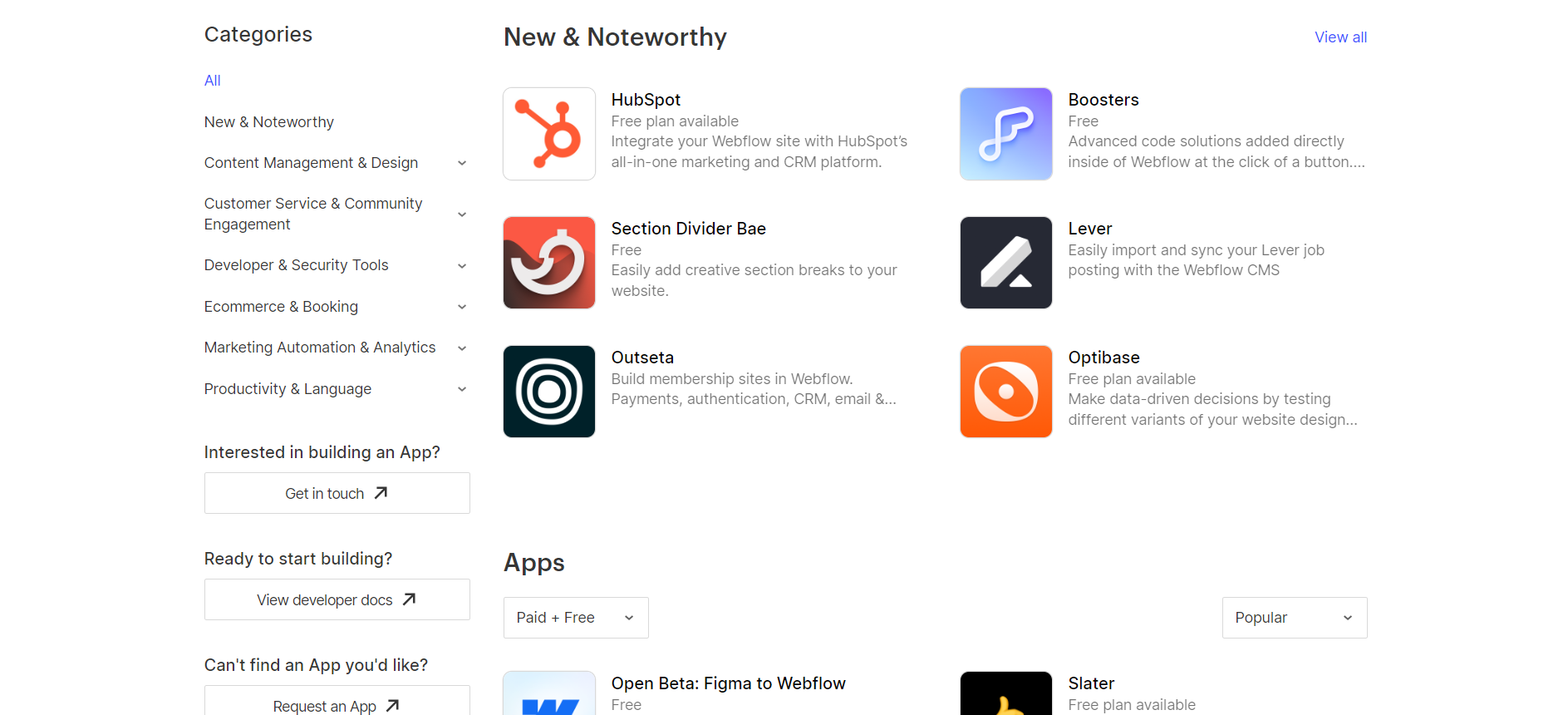
Marketing Features
Marketing featuresAssesses tools and options available for marketing.Score Components:
- SEO tools (40%): Effectiveness of SEO features.
- Marketing automation (30%): Availability and quality of marketing tools.
- Social Media integration (20%): Ease and depth of social media connectivity.
- Email marketing (10%): Quality and usability of email marketing tools.
 5.8
5.8
 7.8
7.8
🏆
Overall Winner: Webflow
. Webflow stands out for its more comprehensive marketing tools, especially in email marketing, blogging, and analytics. Carrd, while simpler, offers basic marketing features and allows for third-party integrations.

|

|
|
|---|---|---|
|
SEO Tools |
|
|
|
Email Marketing |
✓ (through third-party integrations) |
|
|
Blogging |
|
|
|
Social Media Integration |
|
|
|
Analytics and Reporting |
✓ (through Google Analytics integration) |
✓ (with Google Analytics and Mixpanel integration) |
|
Ads and Promotions |
✓ (through third-party integrations) |
✓ (with Google Analytics and Mailchimp integration) |
Customer Support
Customer supportEvaluates the quality and availability of support options.Score Components:
- Response time (40%): Speed of support responses.
- Support quality (30%): Effectiveness and helpfulness of the support.
- Availability (20%): Range of support channels (phone, chat, email).
- Resource richness (10%): Quality of self-help and educational materials.
 6.2
6.2
 8.3
8.3
🏆 Winner: Webflow
. Webflow takes the lead in this category with a customer support score of 8.3. They offer 24/7 customer support through various channels including live chat, email, and a community forum. Additionally, they provide extensive documentation and video tutorials to help users navigate their platform and troubleshoot common problems. For enterprises, Webflow offers a dedicated Customer Success Manager for personalized onboarding, training, and optimization, priority email and chat support from specialists, and an optional SLA for live phone support to address urgent inquiries.
Carrd, with a customer support score of 6.2, offers 24/7 email support with responses typically within 24 hours. However, they do not provide enterprise support, which may be a drawback for larger organizations.
Security
SecurityLooks at the platforms’ security measures and data protection.Score Components:
- Data protection (40%): Safeguards for user and customer data.
- SSL and encryption (30%): Implementation of secure connections.
- Compliance (20%): Adherence to industry security standards.
- Regular updates (10%): Frequency of security updates and patches.
 7.6
7.6
 7.8
7.8
🏆
Winner: Webflow
. Webflow edges out Carrd with a slightly higher security score. Webflow’s commitment to data privacy and security is evident in its robust encryption techniques, strict access controls, regular system updates, and audits. They also offer two-factor authentication for added security.
Although it may not offer the same level of comprehensive security measures as Webflow, Carrd is committed to maintaining a secure platform with automatic SSL for all sites and a commitment to data security and encryption. However, Carrd’s security measures are still commendable and align with the security standards observed by leading website builders.
AI Capabilities
AI capabilitiesMeasures the effectiveness of AI-driven features and tools.Score Components:
- Automation efficiency (40%): Impact of AI on streamlining processes.
- Personalization (30%): AI-driven customization for users or customers.
- AI-Assisted design (20%): Role of AI in website design and functionality.
- Data analysis (10%): Use of AI in interpreting user data and analytics.
 0.0
0.0
 8.3
8.3

|

|
|
|---|---|---|
|
AI Builder |
|
Webflow has announced plans to introduce an AI builder |
|
AI Ecommerce features |
|
|
|
AI Content Generation |
|
|
|
Additional AI features |
|
Webflow has announced plans to introduce additional AI features |
🏆 Winner: Webflow
. Although Webflow does not currently have AI capabilities, it has announced plans to introduce AI features in the future. These features include an AI builder, smart suggestions for design elements and layouts, and AI-powered content management capabilities. On the other hand, Carrd does not have any AI capabilities.
User Management
User ManagementAssesses the platforms’ capabilities in managing user roles, permissions, and accessibility.Score Components:
- Role Customization (40%): Flexibility in creating and defining user roles and
permissions. - Ease of Management (30%): User interface and tools for managing users.
- Access Control (20%): Effectiveness of access control measures for different user
levels. - Scalability (10%): Ability to manage a growing number of users efficiently.
 4.3
4.3
 8.3
8.3
🏆 Winner: Webflow
. Carrd and Webflow offer different approaches to user management.
- Carrd is primarily designed for individual use or small teams, with each account managing its own sites. The platform introduced a Team feature to allow multiple users to collaborate, but traditionally, Carrd sites are managed by a single account holder with full control. The specifics of access levels and permissions for collaborators, if available, are less detailed but generally include editing capabilities.
- In Webflow, the number of users who can edit a website and their access levels vary by plan. Core, Growth, and Enterprise plans offer unlimited editors, while others limit content editors to 3 or 10 per site. Access levels include Designer for full access and Editor for content editing. Workspace roles like Admin, Designer, and Editor ensure collaboration and security through features like the Site Activity Log and role-based permissions.
Webflow User Roles and Access Levels:
| Role | Description | Access Highlights |
|---|---|---|
| Workspace Owner | Full control over Workspace settings and member management. | Edit settings, manage billing, access/edit all sites, invite/remove members, manage permissions. |
| Workspace Admin | Similar to the owner with some restrictions. | Edit settings, manage billing, access/edit all sites, invite/remove members (except owner), manage permissions. |
| Workspace Member | Limited control focused on site interaction. | Download invoices, access/edit sites, invite members. |
| Workspace Guest | Temporary collaborators with limited access. | Access/edit sites. |
| Workspace Commenter | Limited to commenting for feedback on sites. | Create/view/resolve comments, preview sites. |
| Site Admin | Full control at the site level. | Manage permissions, delete/transfer sites, billing management, design and publish changes. |
| Can Design | Design capabilities with some restrictions on publishing. | Design in Designer, create/modify classes and components, publish changes with permission. |
| Can Design (Limited) | Restricted design capabilities for Enterprise customers. | Create new classes, modify created classes, limited publishing capabilities. |
| Can Edit | Content editing without full design privileges. | Edit text/links/images, manage assets, publish Collection items and Ecommerce products. |
| Can Comment (Site Level) | Commenting for feedback at the site level. | Create/view/resolve comments, preview sites. |
Additional Features

|

|
|
|---|---|---|
|
SSL Certificate |
|
|
|
Custom Domain |
|
|
|
Free Custom Domain Included |
|
|
|
International Domains |
|
|
|
Mobile Responsive |
|
|
|
Page Speed |
|
|
|
Website Builder Mobile App |
|
|
|
Convert a Website To An App |
|
|
|
Website Analytics |
|
|
|
Multilingual Sites |
|
|
|
Multiple Users |
|
|
User Feedback
Carrd users overwhelmingly praise the platform for its user-friendly interface, excellent customer support, and attractive templates, which make website creation effortless and enjoyable. The drag-and-drop builder, affordability, and mobile-friendly designs are highlighted as significant benefits. However, some users express limitations, such as the inability to create multi-page websites or a desire for more design options. Overall, Carrd is praised for its affordability, ease of use, and suitability for creating quick, simple webpages.
Webflow, on the other hand, receives high praise for its user-friendly interface, which eliminates the need for coding while offering extensive design flexibility. Users appreciate its scalability, cost-effectiveness, and seamless integration of essential features like forms and CMS. However, some users note a slight learning curve and occasional limitations, particularly in ecommerce functionalities and content management. Overall, Webflow proves to be a powerful tool for building and managing websites, offering robust features for both beginners and experienced developers, albeit with some room for improvement in certain areas like collaborative editing and content management.
The making of this blog
We followed a clear, step-by-step process to write and research this article.
FAQ
Which platform is better for simple, single-page websites?
Can I build a complex, multi-page website with these platforms?
Which platform offers better ecommerce features?
How do Carrd and Webflow compare in terms of ease of use?
Which platform is more affordable?
How do the platforms compare in hosting quality and website speed?
Can I integrate plugins and third-party tools with these platforms?
Which platform provides better customer support?










